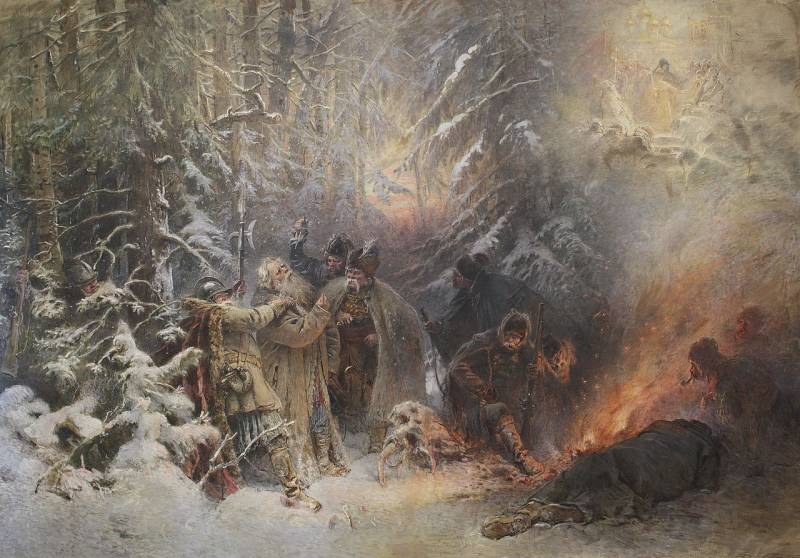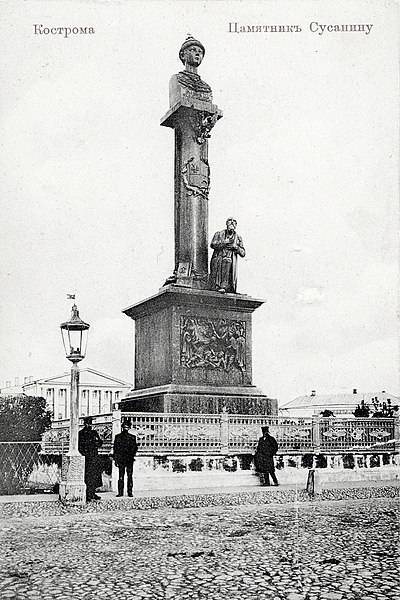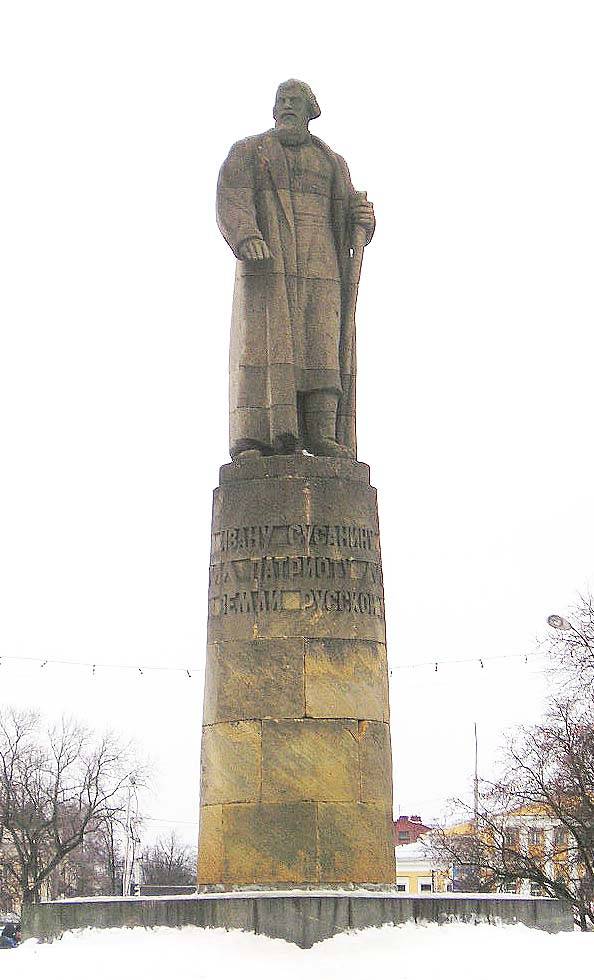Ivan Susanin - patriot of the Russian land

Konstantin Makovsky. Ivan Susanin. 1914
Ivan Susanin
The name of one of the Russian heroes is overgrown with legends and myths, the researchers who raised this topic have created a number of versions that contradict each other.
According to the official version, which also included the mythology of the Romanov royal dynasty, in the winter-spring of 1613, the newly elected sovereign Mikhail Fedorovich Romanov and his mother, nun Marfa Romanova, were in the patrimonial village of Domnino, Kostroma district. A Polish detachment headed here to kill or capture the Russian Tsar. From the point of view of the Polish lords, the legitimate sovereign of Russia was Prince Vladislav (he wore the crown of "Muscovites" until 1634).
As a conductor, the Poles captured a peasant (in a different interpretation, a clerk, an patrimonial headman) Ivan Susanin. He drew the enemies to another place and, with the help of his son-in-law Bogdan Sabinin, warned the Romanovs, who hid in the Ipatiev Monastery. The gentry, realizing that they had been deceived, tortured and killed the hero. The place of death of Ivan Susanin is considered to be the village of Isupovo or Isupovskoye swamp.
Historians argue about the time of the feat: late autumn - winter of 1612, winter - early spring of 1613. Almost nothing is known about Susanin's life. It was a simple peasant or patrimonial headman, as he was associated with the Romanovs. Did he know about the election of Michael as king, or was it still a contender for the throne; whether he knew about the real whereabouts of the Romanovs. Were the Romanovs really in Domnino, or somewhere nearby, or were they not there? The true place of Susanin's death, his grave, is also unknown. There are many questions.
Creation of the official myth of the Romanovs
Proof of the reality of the feat of Ivan Susanin is considered to be a letter of commendation dated November 30 (December 10), 1619, granting Susanin's son-in-law Bogdan Sobinin half the village with "whitewashing" from all taxes and duties "for service to us and for blood, and for patience ...". This charter was repeatedly confirmed: charters of 1633 and 1644 (“To the widow of Sabinin Antonida with children”), a confirmation letter of 1691 (to the descendants of Susanin, who lived in the village of Korobova, “and their children and grandchildren and great-grandchildren, and in their family forever ”), preferential decrees of 1723, 1724 and 1731, confirmation letters of 1741 and 1767 (“to all the descendants of Susanin who lived in the village of Korobova”). The last document dates back to 1837 ("Korobovski Belopashtsam").
The visit of Catherine II to Kostroma in 1767 marked the beginning of an official tradition: to mention Susanin as the savior of Mikhail Romanov. In the "Dictionary of the Geographical Russian State" by A. M. Shchekatov (1804), Susanin appears as the savior of the royal person. In 1812, the writer S. N. Glinka directly elevated Susanin to the ideal of national prowess and self-sacrifice.
This tradition was strengthened during the reign of Nicholas I, when the ideology was carried out - Orthodoxy, autocracy and nationality. Also at this time, the confrontation broke out again along the line Russia - Poland (uprising in the Kingdom of Poland). The composer Mikhail Glinka's opera A Life for the Tsar was released. A monument was erected to the hero in Kostroma - 1851, sculptor V. I. Demut-Malinovsky. Ivan Susanin is depicted on the Millennium of Russia monument in Novgorod.
It is worth noting that the myth was preserved in the USSR. At the first, revolutionary stage, when the revolutionaries destroyed all the "remnants of tsarism", the monument to Ivan Susanin in Kostroma was destroyed. But then, when Stalin began to restore full-fledged state institutions, including history, Ivan Susanin was returned to the camp of folk heroes. But with an emphasis on the patriotism of a common man, when the salvation of the king might not even be mentioned.
In the USSR in 1939, a new "Stalinist" edition of Glinka's famous opera was released, based on the libretto of the poet Sergei Gorodetsky. The plot was heavily edited: new characters appeared in the opera in the person of Minin and Pozharsky. King Sigismund sends a detachment to defeat the Russian militia. The army ends up near Kostroma, in the village where the peasant Ivan Susanin lives. The Poles demand that he show them the way to Minin's camp.
The fact that Susanin saved Tsar Mikhail Fedorovich, who was in a monastery near Kostroma, was not mentioned in the new edition. Moreover, in the text of the libretto there was no mention of Romanov at all. At the direction of Stalin, the opera became known as Ivan Susanin. With such a plot and title, the work was performed on all the opera stages of the Soviet Union. That is, the legend was given a national character.

In 1835, by decree of Tsar Nicholas I, the central square of Kostroma was renamed from Ekaterinoslavskaya to Susaninskaya. On March 14, 1851, a monument designed by Academician V.I. Demut-Malinovsky was erected in its center: a granite column on a quadrangular pedestal was crowned with a bust of the young king, on whose chest a gilded cross stood out brightly. At the base of the column was the kneeling figure of Susanin, to the left of which lay two letters of commendation to his offspring. On the back side of the pedestal there is an inscription: “To Ivan Susanin, for the Tsar, the savior of faith and the kingdom, who laid down his life. Grateful offspring.
Poetry and reality
Even before the revolution, researchers noted that there are no folk legends about Ivan Susanin, they are all bookish in nature. Therefore, the famous pre-revolutionary historian Nikolai Kostomarov, who studied this topic, called the whole history of the feat an "anecdote", which "has become a more or less generally recognized fact."
Kostomarov:
That is, Susanin could well have been a victim not of the Poles, but of Russian thieves (as the robbers were then called).
A prominent Russian historian, one of the founders of the classical history of Russia, Sergei Solovyov also noted that Susanin could have been tortured not by Poles and Lithuanians, but by Russian robbers, Cossacks. Historians did not note large Polish detachments in the winter of 1612–1613. in the Kostroma region. But small gangs of thieves' Cossacks roamed everywhere.
The first Romanovs liked the fairy tale, and they gave a letter and money, confirming the legend. Further court clerics, writers, poets, artists and composers developed the idea. In particular, Glinka figured out how a whole regiment of Poles died in the forest from hunger and cold. In fact, the Polish garrison was literally dying of hunger, they even ate each other, but not in the forest, but in the Moscow Kremlin, where they were let in by the Moscow boyars (including the Romanovs).
At present, apparently, the Stalinist edition of reading the feat of Ivan Susanin should be considered the closest. She is folk. A simple person makes self-sacrifice in the name of the Motherland and the people. It is on such Ivans that the Russian land stands. The rest is poetry.

Monument to Susanin in Kostroma. The 12-meter monument was built according to the design of the Moscow sculptor N. A. Lavinsky and architects Markovsky and Bubnov in 1967.
Information